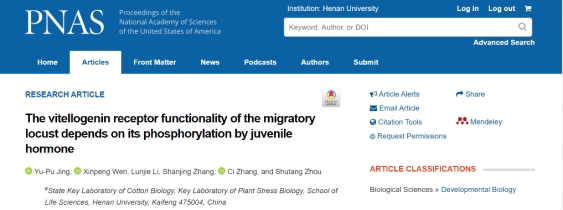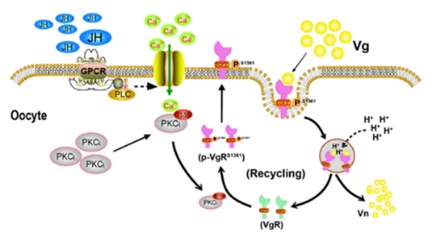
Studies of Locusta migratoria, Helicoverpa armigera and Periplaneta americana reveal that juvenile hormone can induce vitellogenin receptor (VgR) phosphorylation through signaling pathways including G protein-coupled receptor (GPCR), phospholipase C (PLC), and protein kinase C iota (PKCι), and thus regulates receptor-mediated endocytosis and the molecular mechanisms of VgR migration from oocyte to the inner membrane.
In all oviparous animals, vitellogenin is accumulated as yolk proteins in oocyte, which is the prerequisite for the development of oocyte and embryo. VgR, as the "gatekeeper", mediates the endocytosis of vitellogenin into oocytes, and controls the vertical transmission of pathogenic microorganisms and symbiotic bacteria from mother to the next generation. Although VgR and its-mediated endocytosis have been reported in the 1990s, it was not clear how VgR binds vitellogenin for uptake on the oocyte membrane, and how VgR releases vitellogenin and returns to the membrane from the cytoplasm of oocyte.
Vitellogenin synthesis, transport, and VgR-mediated endocytosis are regulated by the juvenile hormone sesquiterpenoids in many insects. Juvenile hormone is one of the most important endocrine hormones in insects, which not only inhibits the metamorphosis from larva to pupa to adult, but also promotes vitellogenesis of adult female insect. Using locust as a model, professor Shutang Zhou's group identified the phosphorylation of Serine1361 in the EGF precursor of VgR using phosphorylated proteomics, liquid chromatography-mass spectrometry, and pharmacological analysis. It was found that juvenile hormone induces phosphorylation of VgR at Serine1361 via a signaling cascade including the GPCR, PLC and PKC ι. Subsequently, VgR can bind to vitellogenin on oocyte membrane based on phospho-Serine1361, and then enter oocyte through endocytosis. Finally, VgR was dephosphorylated under the highly acidic conditions in the endosome and was separated from Vg-VgR complex, so that vitellogenin is stored as yolk and the VgR is phosphorylated again by PKCι for returning to the oocyte membrane. Further studies on cotton bollworm and periplaneta Americana showed that VgR phosphorylation-depended endocytosis and recycling were highly conserved evolutionally.
PNAS is one of the world’s top academic journals with the topics including biology, medicine, chemistry, physics, mathematics, ecology and so on. In this study, associate professor Yu-pu Jing is the first author, professor Shutang Zhou is the corresponding author, and doctoral candidate Lunjie Li and postgraduate student Ci Zhang are the co-authors. Henan University is the independent completion unit. This research was supported by the Key Project of National Natural Science Foundation of China (NSFC), the Key Project of NSFC-Henan union funding and the Youth Project of NSFC.

Fig 1. VgR phosphorylation- depended endocytosis and subcellar localization with evolutionary conservatism.

Fig 2. A proposed model for JH-stimulated VgR phosphorylation, Vg internalization and VgR recycling.
As reported that Professor Shutang Zhou focuses on the characteristics of pest mass reproduction, environmental adapted outbreak in plant biological stress, and research on the hormonal and nutritional regulatory mechanism of insect reproduction. In recent years, a series of academic papers has been published in PNAS, Development, Cellular and Molecular Life Sciences, PLoS Genetics and other top academic journals. The hypothesis that the JH/Met/ Kr-h1 pathway not only inhibits larval metamorphosis but also promotes adult reproduction was proposed and elaborated. The molecular mechanism of massive synthesis of vitellogenin and simultaneous maturation of eggs was explored, and the synergistic regulation mechanism of hormone-nutrition-epigenetic factors on massive oviposition was explained.
Paper link: https://www.pnas.org/content/118/37/e2106908118

 Research /
Research Achievements /
Science & Technology /
Key Laboratory of Photovoltaic Materials /
Content
Research /
Research Achievements /
Science & Technology /
Key Laboratory of Photovoltaic Materials /
Content


